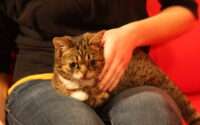Are Ragdolls Vocal? The Melodic Secrets of These Feline Songbirds
Welcome to our in-depth exploration of Ragdoll cats and their unique vocal traits. Ragdolls are a beloved feline breed known for their striking appearance and sweet, gentle personalities. In this article, we’ll embark on a fascinating journey to unravel the mystery of whether Ragdoll cats are truly vocal companions.
Ragdoll cats are a distinctive breed that has captured the hearts of cat enthusiasts around the world. With their striking blue eyes, semi-long fur, and a penchant for going limp when held, Ragdolls have a captivating charm that’s hard to resist.
However, one aspect of their personality often debated by cat lovers is their vocal nature. Some believe that Ragdolls are silent, while others have experienced their melodious meows, purrs, and even charming chirps. In the quest to uncover the truth about Ragdoll cat vocalizations, we’ll delve deep into their history, characteristics, and explore the sounds that make them unique.
Understanding Ragdoll Cats
Before we dive into the world of Ragdoll cat vocalizations, it’s essential to get to know these magnificent felines a little better. Ragdoll cats, as their name implies, seem to melt in your arms when you hold them. They’re large, affectionate, and often referred to as “puppy-like” due to their friendly and docile nature.
Ragdolls have a fascinating history that dates back to the 1960s when a California woman named Ann Baker developed the breed. These cats are the result of selective breeding, creating a breed with stunningly beautiful colorpoints, lush fur, and distinctive blue almond-shaped eyes. Their soft, semi-long fur requires regular grooming, and their striking appearance turns heads wherever they go.
In terms of temperament, Ragdoll cats are known for their easy-going and laid-back demeanor. They’re not your typical high-energy, rambunctious cats. Instead, they tend to be gentle and adaptable, making them fantastic companions for families, singles, and seniors alike.
Now, as we venture deeper into this article, we’ll explore whether their vocalizations match their sweet personalities or if they’re indeed the “silent” felines some claim them to be. So, fasten your seatbelts and get ready to journey through the world of Ragdoll cat vocalizations – it’s going to be a purrfect adventure!
Ragdoll Cat Vocalizations
First and foremost, let’s unravel the mystery surrounding Ragdoll cat vocalizations. Just like any other cat breed, Ragdolls communicate with us and express themselves through a wide range of distinctive sounds. The question we aim to answer is whether these vocalizations are prominent and unique to Ragdolls, or if they are simply part of their charming kitty repertoire.
Common vocalizations of Ragdoll cats
Ragdolls are not completely silent creatures, and their vocalizations can vary from soft meows to melodious purrs. Some owners even delight in the enchanting chirping sounds they make. But let’s break down these sounds and understand what they mean.
- Meowing: Ragdoll cats, like most cats, meow to communicate with their humans. However, their meows are often softer and more melodious compared to other breeds. The reasons behind their meowing can be diverse, ranging from seeking attention, expressing hunger, or simply having a little chit-chat.
- Purring: Ragdoll cats are renowned for their luxurious purring. Their purrs can be quite pronounced and soothing, often occurring when they’re content or seeking affection. The melodic hum of a purring Ragdoll is a delightful experience for any cat lover.
- Chirping: One of the unique traits of Ragdolls is their propensity to chirp. They make small, bird-like chirping sounds, often while watching birds through the window or during playtime. This charming behavior adds an extra layer of intrigue to their vocal repertoire.
Meowing in Ragdoll Cats
Let’s now take a closer look at the enchanting world of meowing in Ragdoll cats. Meowing is a fundamental form of communication for cats, and it plays a significant role in expressing their needs, emotions, and desires. For Ragdolls, meowing is a key aspect of their interaction with their human companions.
The range of meow sounds in Ragdoll cats
Ragdolls are known for their soft, melodious meows that set them apart from many other breeds. The range of meow sounds they produce can be quite diverse, and Ragdoll owners often find themselves enchanted by the unique tones of their feline friends. From gentle and pleading to sweet and endearing, Ragdoll meows are a true auditory delight.
Reasons for meowing
Understanding why Ragdoll cats meow is crucial for their well-being and building a strong human-feline bond. Here are some common reasons behind their meowing:
- Communication: Meowing is their primary way of communicating with their human companions. Whether it’s to greet you when you come home or request some quality playtime, Ragdolls use their meows to get your attention.
- Seeking attention: Ragdolls thrive on human interaction and companionship. They may meow to get you to engage with them, especially if they’re feeling a bit lonely or in need of affection.
- Stress or discomfort: If your Ragdoll is feeling stressed or uncomfortable due to changes in their environment or health issues, they may vocalize their distress through meowing.
Purring in Ragdoll Cats
Purring is another enchanting aspect of Ragdoll cat vocalizations. Their purring behavior is unique, often standing out as a defining characteristic of this breed. Understanding why and when Ragdolls purr is a heartwarming journey into their affectionate nature.
Understanding the unique purring behavior of Ragdolls
Ragdoll cats are renowned for their luxurious purring, which is often described as a gentle, rhythmic hum. This soothing sound is a testament to their contentment and their desire for closeness. When you hear a Ragdoll purring, it’s a sign that they are happy and relaxed.
Why Ragdolls purr
The reasons behind a Ragdoll cat’s purring are as heartwarming as the sound itself. Purring serves various purposes for these gentle giants:
- Contentment: Ragdolls are known for their laid-back and easygoing personalities. When they’re content, comfortable, and feeling loved, they express their happiness through purring.
- Bonding with humans: Purring is also a way for Ragdolls to bond with their human family members. The sound of their purring can be a reassuring and calming presence in your home.
- The therapeutic benefits of Ragdoll cat purring: Studies have shown that the soothing sound of a cat’s purring can have therapeutic effects, including reducing stress and anxiety in humans. Having a purring Ragdoll by your side can be incredibly comforting.
Chirping in Ragdoll Cats
Now, let’s turn our attention to one of the most endearing and unique aspects of Ragdoll cat vocalizations – chirping. Ragdolls are known to produce charming chirping sounds that captivate their owners and add an extra layer of personality to these delightful felines.
The adorable chirping sounds of Ragdoll cats
Chirping is an exceptional vocal trait exhibited by Ragdoll cats. These small, bird-like sounds are an absolute delight to witness. Ragdolls often produce these chirps while they’re engaged in various activities or simply observing their surroundings.
These delightful chirps can be heard when your Ragdoll is watching birds flutter by outside the window, participating in playful antics, or even when they’re excited to see you after a long day. The musical chirping adds an element of surprise and charm to your Ragdoll’s vocal repertoire.
Occasions when Ragdolls chirp
Ragdolls may chirp in various situations, and understanding the contexts can deepen your connection with your feline companion.
- Bird-watching: Ragdolls are known for their fascination with birds. As they watch these feathered creatures from the window, they may express their excitement and curiosity through chirping sounds.
- Playful behavior: Ragdolls have a playful and fun-loving side. When engaged in playful activities, such as chasing toys or play-fighting with other pets, they may emit those adorable chirps as a sign of enjoyment.
Factors Influencing Ragdoll Cat Vocalizations
The vocal traits of Ragdoll cats are not solely defined by their breed; various factors influence the frequency and nature of their vocalizations. Understanding these factors can help you decode your Ragdoll’s unique vocal behavior and respond appropriately.
- Age: Age plays a significant role in a Ragdoll cat’s vocalizations. Just like with other cat breeds, kittens are typically more vocal than their adult counterparts. As Ragdoll kittens grow and mature, they may undergo changes in their vocal behavior. While kittens may meow more frequently to express their needs and seek attention, adult Ragdolls may exhibit a more refined and specific form of communication.
- Health-related concerns: Ragdoll cats, like all cats, may use vocalizations to communicate discomfort, pain, or health-related issues. Paying attention to changes in your Ragdoll’s vocal behavior is essential for their well-being. If you notice unusual or excessive vocalizations, it’s crucial to consult with a veterinarian to rule out any underlying health concerns.
- Socialization and environmental factors: The environment in which a Ragdoll cat is raised and their interactions with humans and other animals play a vital role in shaping their vocal personality. Well-socialized Ragdolls tend to be more relaxed and confident in their interactions, which can influence their vocal behavior positively.
Understanding and Responding to Ragdoll Cat Vocalizations
In our ongoing quest to decipher the melodious world of Ragdoll cat vocalizations, it’s crucial to not only understand why they meow, chirp, and purr but also how to respond to these delightful sounds. Building a strong human-feline bond involves recognizing and appropriately reacting to your Ragdoll’s vocal cues.
Learning to interpret your Ragdoll’s vocal cues
Every Ragdoll cat is unique, and their vocalizations may carry different meanings. To truly connect with your feline companion, it’s essential to learn their specific vocal cues. Whether it’s a distinctive meow when they’re hungry or a chirp of excitement during playtime, observing their behavior and context is key to understanding their communication.
Tips for responding to meows, purrs, and chirps
- Meows: When your Ragdoll meows, consider the context. If it’s a soft, friendly meow, it might be an invitation for play or affection. If it’s a more insistent meow, they could be expressing a need, such as hunger or a request to go outdoors. Responding promptly to their meows can strengthen your bond and ensure their well-being.
- Purrs: When your Ragdoll starts purring, it’s a clear sign that they’re content and happy. Join in the moment by petting them, cuddling, or engaging in interactive play. The sound of their purring is not only therapeutic for them but also for you.
- Chirps: Chirping is a delightful aspect of Ragdoll vocalizations. When your cat chirps during bird-watching or play, enjoy the interaction. If they’re excited by birds outside, you can provide them with a safe, window-side perch to enjoy the show.
Tips for Ragdoll Cat Owners
Being a Ragdoll cat owner is a unique and rewarding experience. These enchanting felines have distinctive vocal traits and personalities, and to make the most of your companionship, here are some valuable tips to consider:
- Providing a stimulating environment: Ragdoll cats are intelligent and curious by nature. Create an environment that stimulates their minds and keeps them engaged. Interactive toys, puzzle feeders, and cozy spots by the window for bird-watching can all enhance their quality of life and reduce any need for excessive vocalizations born out of boredom.
- Ensuring regular vet check-ups: Regular visits to the veterinarian are essential to ensure your Ragdoll’s health and well-being. Addressing any health concerns promptly can help prevent excessive vocalizations that may signal discomfort or distress.
- Creating a comfortable and stress-free home: Ragdolls thrive in calm and stress-free environments. Maintain a predictable routine, provide comfortable resting spots, and offer plenty of love and attention to keep them content.
- Training and socializing: Ragdoll cats are sociable creatures. Proper training and early socialization can help them develop well-adjusted vocal behavior. Encourage positive interactions with humans and other pets, which can reduce stress and prevent excessive vocalizations.
Conclusion
Our journey into the vocal world of Ragdoll cats has revealed the delightful and enchanting nature of these feline companions. Contrary to the misconception that Ragdolls are silent, we’ve discovered that they possess a wide range of vocalizations, each with its own distinctive charm.
Ragdoll cats are not only renowned for their striking appearance but also for their friendly and affectionate personalities. Their meows, purrs, and chirps are integral to their interactions with their human families, making them wonderful and communicative pets.
As we conclude our exploration, we encourage prospective cat owners to consider Ragdolls as a viable choice for a feline companion. With their vocal charm, gentle nature, and captivating beauty, Ragdoll cats can be a heartwarming addition to any household.
Frequently Asked Questions
Are all Ragdoll cats vocal, or is it a breed-wide trait?
While vocalizations are a common trait among Ragdoll cats, not every individual cat within the breed is equally vocal. The degree of vocalization can vary from cat to cat, and it may also change with age and socialization.
Do Ragdoll cats meow more than other cat breeds?
Ragdoll cats are known for their distinctive meows, but whether they meow more than other breeds can depend on the cat’s personality and environment. Some Ragdolls can be quite chatty, while others may be more reserved.
Is there a particular age when Ragdoll cats are most vocal?
Kittens are generally more vocal as they communicate their needs and explore the world. As Ragdoll cats mature into adults, they may become less vocal. However, individual variation exists, and some adult Ragdolls remain quite vocal.
Are there any health concerns associated with excessive vocalization in Ragdoll cats?
Excessive vocalization in Ragdoll cats can sometimes indicate underlying health issues or discomfort. If you notice a significant change in your cat’s vocal behavior, it’s advisable to consult with a veterinarian to rule out any health concerns.
Can I train my Ragdoll cat to be less vocal if it’s becoming bothersome?
Yes, you can work with your Ragdoll to reduce excessive vocalization through positive reinforcement training. Providing mental and physical stimulation, as well as addressing any potential stressors, can help mitigate excessive meowing.
How can I encourage my Ragdoll cat to chirp and engage in playful behavior?
Ragdolls often chirp during playful moments. To encourage this behavior, provide interactive toys and playtime that mimics hunting. Feather toys and laser pointers are excellent options to engage your Ragdoll’s playful instincts.
What is the typical sound of a Ragdoll cat’s purring?
Ragdoll cats are known for their luxurious, rhythmic purring. The sound is often described as a gentle hum or soft melody. It’s soothing and indicates contentment and happiness.
Do Ragdoll cats chirp when watching birds outside the window?
Yes, Ragdoll cats are often fascinated by birds. When they observe birds outside the window, they may express their excitement and curiosity through adorable chirping sounds.
Are Ragdoll cats suitable for families with children?
Yes, Ragdoll cats are generally well-suited for families with children. Their gentle and easygoing nature makes them great companions for kids. However, it’s essential to supervise interactions to ensure a positive and safe experience for both the cat and the child.
Can Ragdoll cats be trained to communicate specific needs and commands?
Yes, Ragdoll cats are intelligent and can be trained to respond to specific cues and commands. Positive reinforcement training can help establish effective communication between you and your Ragdoll.



